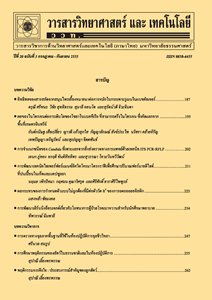แผนภูมิควบคุมคุณภาพสำหรับการเฝ้าสังเกตสัดส่วนของเสียในกระบวนการผลิตเมื่อกระบวนการออกนอกการควบคุม
Main Article Content
Abstract
บทคัดย่อ
งานวิจัยนี้มีวัตถุประสงค์เพื่อนำเสนอแผนภูมิควบคุมสัดส่วนของเสีย AC โดยใช้ช่วงความเชื่อมั่นของ Agresti และ Coull มาประยุกต์สร้างขีดจำกัดควบคุมสำหรับสัดส่วนของเสียในกระบวนการผลิต และจำลองข้อมูลให้มีการแจกแจงทวินามด้วยวิธีมอนติคาร์โลทั้งหมด 450 สถานการณ์ เพื่อเปรียบเทียบประสิทธิภาพในการตรวจพบการเปลี่ยนแปลงไปของสัดส่วนของเสียในกระบวนการผลิตของแผนภูมิควบคุมที่นำเสนอกับแผนภูมิควบคุมคุณภาพสำหรับสัดส่วนของเสียแบบอื่น ๆ อีก 3 แผนภูมิ คือ แผนภูมิควบคุมสัดส่วนของเสีย แผนภูมิควบคุมค่าเฉลี่ยเคลื่อนที่สำหรับสัดส่วนของเสีย และแผนภูมิควบคุมบีตา โดยกำหนดปัจจัยต่าง ๆ ดังนี้ สัดส่วนของเสีย ( ) เท่ากับ 0.005, 0.02, 0.05, 0.1, 0.2 ขนาดตัวอย่าง ( ) เท่ากับ 10, 20, 30, 50, 150, 300 และระดับการเปลี่ยนแปลงค่าสัดส่วนของเสีย ( ) ในกระบวนการผลิตเท่ากับ 1.3, 1.5, 2.0, 3.0, 4.0 ซึ่งเกณฑ์ที่ใช้ในการเปรียบเทียบประสิทธิภาพของแผนภูมิควบคุม คือ ความยาววิ่งเฉลี่ย ( ) ผลการวิจัยพบว่าเมื่อ = 0.005, 0.02 แผนภูมิควบคุมบีตามีประสิทธิภาพในการตรวจพบความผิดปกติของกระบวนการได้ดีในเกือบทุกระดับของ และ แต่เมื่อสัดส่วนของเสียในกระบวนการมีค่ามากขึ้น กล่าวคือ = 0.05, 0.1, 0.2 แผนภูมิควบคุมค่าเฉลี่ยเคลื่อนที่สำหรับสัดส่วนของเสียจะมีประสิทธิภาพดีกว่า โดยแผนภูมิควบคุมสัดส่วนของเสีย AC ที่นำเสนอพบว่าจะมีประสิทธิภาพดีเมื่อ = 3.0, 4.0 ในเกือบทุกระดับของ และ
คำสำคัญ : แผนภูมิควบคุม; ความยาววิ่งเฉลี่ย; สัดส่วนของเสีย; การแจงแจงทวินาม
Abstract
The objective of this research is to propose the control chart. The Agresti and Coull confidence interval is applied to construct the control limits for fraction nonconforming in production process when the data are binomial distributed. The simulation study is conducted by Monte Carlo technique for 450 situations to compare the efficiency for detection the shift of fraction nonconforming in production process of the proposed control chart with three quality control charts, namely, p chart, moving average p chart, and beta control chart. The studied factors consist of five levels for fraction nonconforming ( ) which are equal to 0.005, 0.02, 0.05, 0.1, 0.2, the sample size ( ) is defined at 10, 20, 30, 50, 150, 300, and the shift of fraction nonconforming ( ) is determined at 1.3, 1.5, 2.0, 3.0, 4.0. The criterion for an efficiency comparison in this study is the average run length ( ). The research results show that in case of = 0.005 and 0.02, the beta control chart seems to be the efficiency to detect the shift of fraction nonconforming in process for almost all levels of and . However, when the fraction nonconforming in process increases ( = 0.05, 0.1, 0.2) the performance of moving average chart is better. In addition, the proposed control chart shows good performance when = 3.0, 4.0 for almost all levels of and .
Keywords: control chart; average run length; fraction nonconforming; binomial distribution


